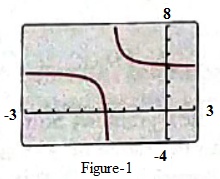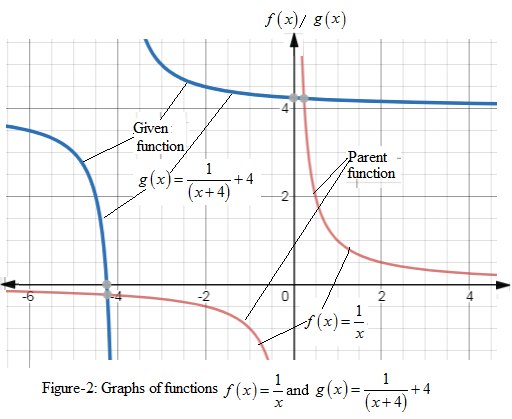
To identify: The parent function and the transformation shown in the graph and write an equation for the function represented by the graph.
Answer to Problem 64CR
The parent function of function is
Explanation of Solution
Given information:
The given function is shown in Figure-1.
Concept used:

A parent function is the simplest function of a family of functions represents the definition (or shape) of the family of functions. For example, the family of quadratic functions has the general form
Identification:
The shape of given graph (Figure-1) appears similar to the graph of a cubic function
If we shift the graph of function
The equation of function obtained by shifting the graph of function
Thus, equation the transformed function say

The graphs functions
Thus, the parent function of the function whose graph is shown in given figure (Figure-1) is
Conclusion:
The parent function of function is
Chapter 1 Solutions
EP PRECALC.GRAPHING APPR.-WEBASSIGN-1YR
 Calculus: Early TranscendentalsCalculusISBN:9781285741550Author:James StewartPublisher:Cengage Learning
Calculus: Early TranscendentalsCalculusISBN:9781285741550Author:James StewartPublisher:Cengage Learning Thomas' Calculus (14th Edition)CalculusISBN:9780134438986Author:Joel R. Hass, Christopher E. Heil, Maurice D. WeirPublisher:PEARSON
Thomas' Calculus (14th Edition)CalculusISBN:9780134438986Author:Joel R. Hass, Christopher E. Heil, Maurice D. WeirPublisher:PEARSON Calculus: Early Transcendentals (3rd Edition)CalculusISBN:9780134763644Author:William L. Briggs, Lyle Cochran, Bernard Gillett, Eric SchulzPublisher:PEARSON
Calculus: Early Transcendentals (3rd Edition)CalculusISBN:9780134763644Author:William L. Briggs, Lyle Cochran, Bernard Gillett, Eric SchulzPublisher:PEARSON Calculus: Early TranscendentalsCalculusISBN:9781319050740Author:Jon Rogawski, Colin Adams, Robert FranzosaPublisher:W. H. Freeman
Calculus: Early TranscendentalsCalculusISBN:9781319050740Author:Jon Rogawski, Colin Adams, Robert FranzosaPublisher:W. H. Freeman
 Calculus: Early Transcendental FunctionsCalculusISBN:9781337552516Author:Ron Larson, Bruce H. EdwardsPublisher:Cengage Learning
Calculus: Early Transcendental FunctionsCalculusISBN:9781337552516Author:Ron Larson, Bruce H. EdwardsPublisher:Cengage Learning





